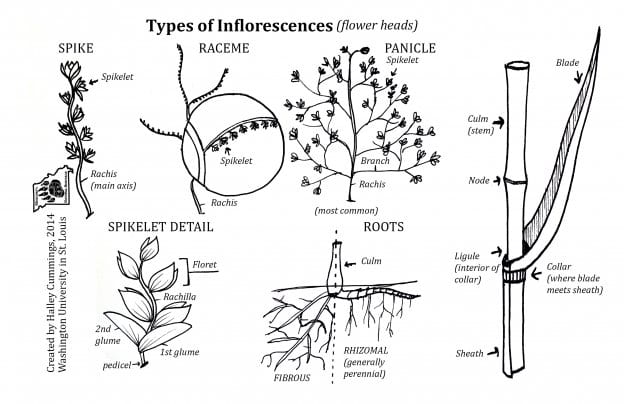A few of the most common species of grass found in Missouri, complete with a printable identification card. 
 This identification card details eight of the most prevalent species of grass in Missouri. The front includes illustrations of each species and identifying characteristics. The grasses are found across a wide range of habitats, from prairies and open woods to streams and wet lands. The back of the card is especially helpful for the novice grass identifier. It includes labeled illustrations of the basic parts of a grass plant.
This identification card details eight of the most prevalent species of grass in Missouri. The front includes illustrations of each species and identifying characteristics. The grasses are found across a wide range of habitats, from prairies and open woods to streams and wet lands. The back of the card is especially helpful for the novice grass identifier. It includes labeled illustrations of the basic parts of a grass plant.
Anatomy of a Grass 1
Grasses, for all their apparent simplicity, are complex organisms that vary widely. When attempting to differentiate species, the inflorescence, or flower, is of particular importance. There are three main types of inflorescences, the spike, raceme, and panicle. Each of these is shown on the back of the card. Another key feature of the grass is the root type: rhizomal or fibrous. This is often easy to discover by simply uprooting a plant, even in the winter, and provides clues as to the seasonal habits of the grass species. Annual grasses tend to have a fibrous, loose root system, with many slender roots. Perennial grasses generally have rhizomal roots, which are thicker, starchy roots that allow the plant to store energy over the winter. Grass stems are slightly more difficult to use as identification than roots or inflorescences. They are commonly known as culms, and their alignment with each other and relationship with the ground vary among species. Finally, grass leaves (known as blades) are extremely important to the function of the plant. Each blade can be anywhere from flat to entirely folded in on itself, a characteristic that often points to water availability for the species. Folded, “spiky” bladed grasses provide less surface area for water to be lost through transpiration and are therefore more tolerant of droughts than plants with open blades. Knowing all of these characteristics and their relevance to the function of the plant allows the casual grass enthusiast to infer a lot of information from one quick look at a plant.
Grass in Missouri3
Missouri’s history with grass is a long one. Much of the state, prior to the European settlement, was covered in prairie. These diverse grasslands were largely converted to farmland, though some northern counties of the state still house original prairie land. Most notably, Prairie State Park is home to native prairie land and reintroduced herds of buffalo and elk. Much of the prairie was tallgrass, and some of the varieties of prairie grass, such as little bluestem and Kentucky bluegrass, are still commonly found in the state. In fact, though much of the dedicated grasslands of Missouri have been broken apart, there remains great diversity of grass across the state. In fact, 12 of the 14 tribes of grasses endemic to the United States are found within Missouri, accounting for a total of 245 species in 79 genera. Of those species, the majority are perennials, with five times fewer annual species.2
For more information on identifying many types of grass, take a look at How to Identify Grasses & Grasslike Plants by H.D. Harrington. To further explore the grasses endemic to Missouri, check out The Grasses of Missouri by Clair L. Kucera.
1How to Identify Grasses & Grasslike Plants by H.D. Harrington
2 The Grasses of Missouri by Clair L. Kucera
3A Living Experiment. The Missourian
For a printable PDF version of this card, click here